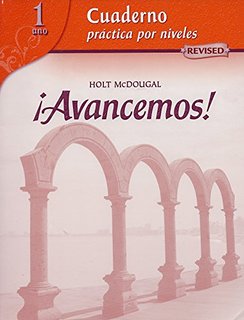
All Solutions
Page 7: Gramatica A
The objective of this exercise is to practise the use of the verb “gustar”. You have noticed that this type of verbs uses the topic as the grammatical subject, whilst the person it refers to becomes the indirect object in the dative case. Always use the appropriate unstressed form of the personal pronoun before the verb. The use of the stressed form is optional and, when used, it should always come in pair with the unstressed form.
For example, “Me gusta el chocolate.” and “A mí me gusta el chocolate.” are valid sentences, whereas *”A mí gusta el chocolate.” is incorrect.
Instead of using the stressed form of the pronoun, you may use the noun that it substitutes. In any case, always remember to use the unstressed form of the pronoun.
For example, “Le gusta mirar la tele.” and “A la profesora le gusta mirar la tele.” are valid sentences, whereas *”A la profesora gusta mirar la tele.” is incorrect.
In language, this doubling of the indirect object is called reduplication.
The stressed form of the personal pronoun in dative is given for each sentence. They contain hints about who the indirect object is. Recognise which personal pronoun they correspond to and use it in its adecuate form in dative. You may use the below solution for further guidance.
2. nos
3. les
4. te
5. me
The objective of this exercise is to practise the co-ordinate use of personal pronouns in dative with the verb “gustar”.
Grammatical subjects and reduplicated indirect objects are given for each sentence. The task is to use the correct unstressed pronoun, that corresponds to the indirect object, and the correct form of the verb, that corresponds to the subject. Refer to the following analysis for further clarification.
The first given sentence is:
A mis amigas no ___ comer papas fritas.
Firstly, find the indirect object. The preposition “a” usually points at the indirect objects, which in this case is “A mis amigas” (lit. to my friends). Here, we see that the indirect object corresponds to the third grammatical person in plural. This means that the correct pronoun is “les” (lit. [to] them).
Secondly, find the grammatical subject. It will always follow the verb “gustar”, which indicates that our subject is “comer [papas fritas]”. Having an infinitive as the subject means it will be in singular, thus you would use the form “gusta”.
Finally, put the two together in their respective order and complete the sentence:
A mis amigas no les gusta comer papas fritas.
Refer to the below solutions for further guidance.
2. le gusta
3. les gusta
4. me gusta
5. les gusta
6. te gusta
The purpose of this exercise is to practise the co-ordinated use of personal pronouns and the verb “gustar”.
The reduplicated indirect object is given for each sentence. The subject, however, is hidden in the pictures.
In the first image, you can see two men sitting: one is reading a book and the other one is relaxing. From here, we see that the subject will be “leer libros” (to read books) and “descansar” (relax). Understand them as two separate subjects and use the singular form of the verb: “gusta”.
Following the provided indirect object, the correct unstressed form of the personal pronoun is “les”. Thus, the correct solution for the first image would be:
A ellos les gusta leer libros y descansar.
You may refer to the below solutions for further guidance.
2. A ella le gusta jugar al fútbol.
3. A él le gusta comer helado.

